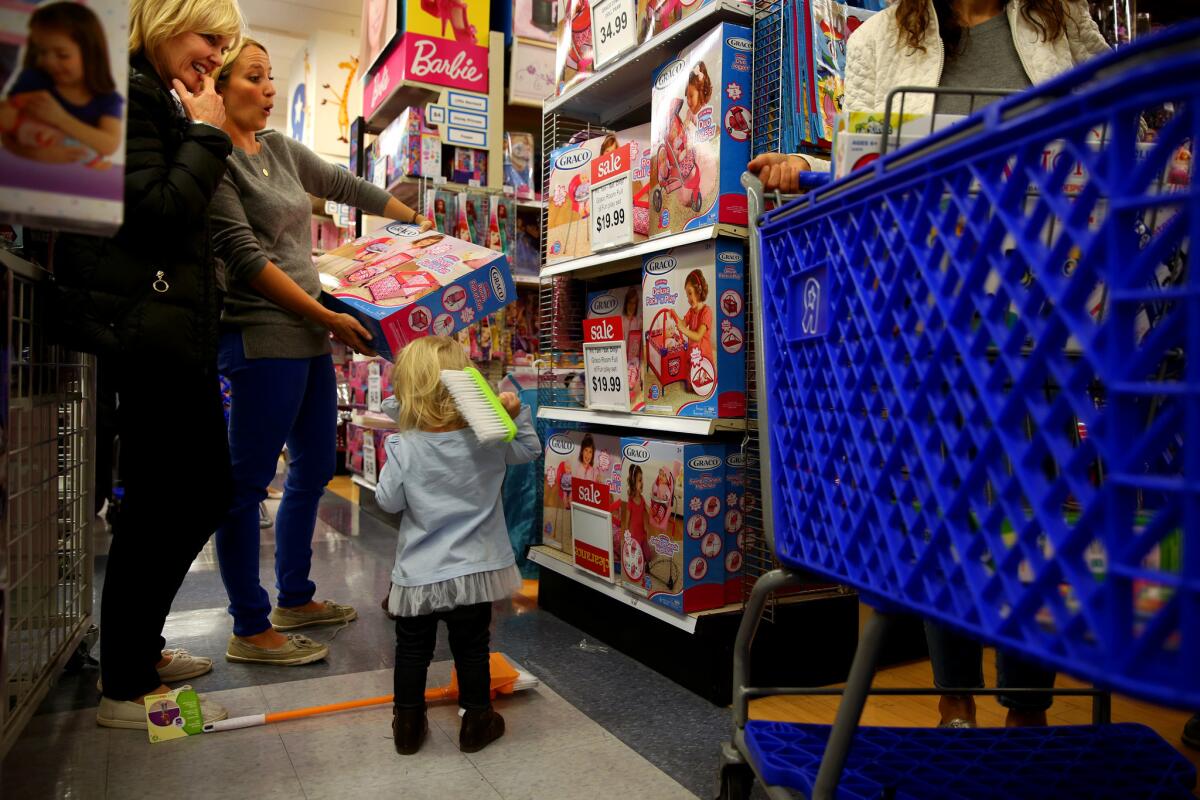Tariffs will boost prices on toys and smartphones — but not until next year

Over the last year and a half, retailers have watched the dizzying pace of the U.S.-China trade war with a growing sense of trepidation.
When the Trump administration announced this year that consumer goods such as shoes and clothing could face a 15% duty, companies chose to get ahead of the tariff price hikes and stocked up on items as early as the summer. That means shoppers shouldn’t see higher prices reflected on their receipts on Black Friday or during this holiday season.
But if a new round of tariffs goes into effect in mid-December as planned, people could begin paying more for toys or big-ticket items such as laptops and smartphones by early next year.
“In 2020, it will be a big deal,” said James Bohnaker, economist at research and analysis firm IHS Markit.
Earlier rounds of tariffs levied by the Trump administration on Chinese goods largely targeted so-called intermediate goods, such as aluminum and plastic sheets, which are not finished products that can be bought in stores.
The Trump administration originally intended to subject consumer goods such as toys, laptops, smartphones and digital cameras to a 15% duty by Sept. 1, but put that off until Dec. 15, citing the potential effect on American shoppers during the holiday season.
Even with the delay, the impending tariffs have still been a major concern for the consumer electronics industry.
Since the tit-for-tat trade war began in spring of last year between the U.S. and China, that industry was hit by $15.5 billion in tariff costs that were either absorbed by manufacturers or passed on to consumers. The higher costs mostly applied to components and tech accessories such as cables and cellphone cases, said Rick Kowalski, senior manager of industry and business intelligence at the Consumer Technology Assn. trade group. In September alone, the consumer tech industry shouldered $2 billion in tariff costs.
If the new tariffs on consumer goods go into effect Dec. 15, companies up and down the supply chain, as well as retailers, will have to decide how they’ll handle the additional costs.
“Everybody is in a pinch,” Kowalski said. “That $15 billion has to come from somewhere.”
For some companies, that might mean passing the cost on to the consumer. JLab Audio Chief Executive Win Cramer told CNBC in August that the Carlsbad, Calif., company’s headphones would probably cost more as a result of tariffs. He also predicted that discounting would not be as strong this holiday season as it has been in the past.
“We’ve never seen this before,” Cramer said. “We don’t have a playbook to follow.”
The toy industry is also grappling with how to plan for the unpredictable. Companies have held off on investing in new product lines because of uncertainties over tariffs and pricing, said Rebecca Mond, vice president of federal government affairs for the Toy Assn. trade group.
In some cases, companies have chosen to absorb the cost of the tariffs, rather than risk losing customers.
Tom’s Model Inc., a 39-year-old toy company in downtown Los Angeles, upped its orders for a signature product, a battery-operated canine called the Lucky Dog, and ate a 10% price increase. The company has sold the $5.99 toy since its early days and it has nostalgic appeal, said Tommy Yip, owner of Tom’s Model and son of the founder.
“My father was known for that specific piece of toy,” he said. “I do want to retain our customer loyalty.”
Sometimes, though, negotiations with other players in the supply chain don’t go as expected.
Eric Tung of Torrance-based Fera, a ski clothing specialty company, thought he was in the clear when he ordered this year’s batch of insulated apparel from his vendors in China. The goods were in transit before Sept. 1, when the first round of tariffs on consumer goods was implemented.
But his items were hit with the 15% markup anyway. Tung tried negotiating with retailers in hopes that they would share the burden but was told they didn’t want their margins affected.
As a small, niche company, Tung said, Fera was forced to absorb some of the cost and pass the rest to consumers. A ski jacket that would cost $200 at wholesale is now priced for retail at $220, a 3% to 5% price increase, Tung said.
“I’m not Patagonia or North Face,” he said. “I can’t say I’m raising my prices and you’ll still buy from me. It’s not good for anyone — consumer or business — when you have big dramatic price increases.”
More to Read
Inside the business of entertainment
The Wide Shot brings you news, analysis and insights on everything from streaming wars to production — and what it all means for the future.
You may occasionally receive promotional content from the Los Angeles Times.












